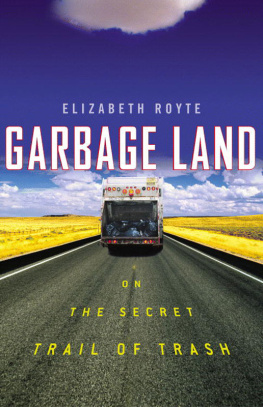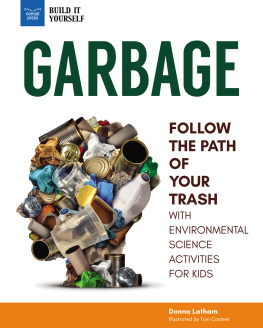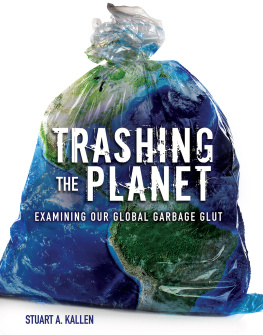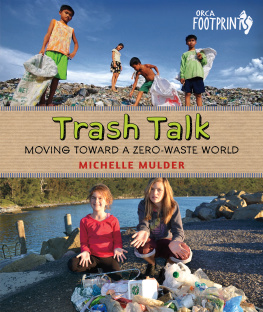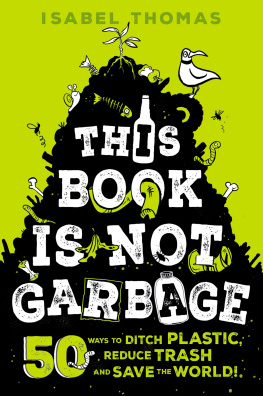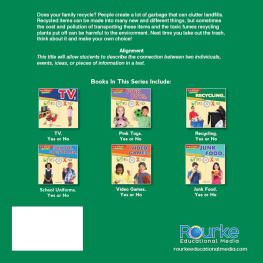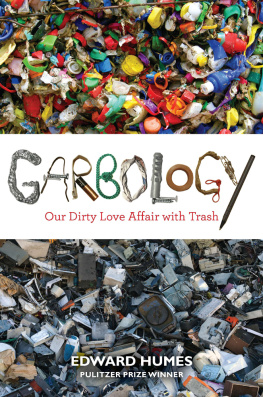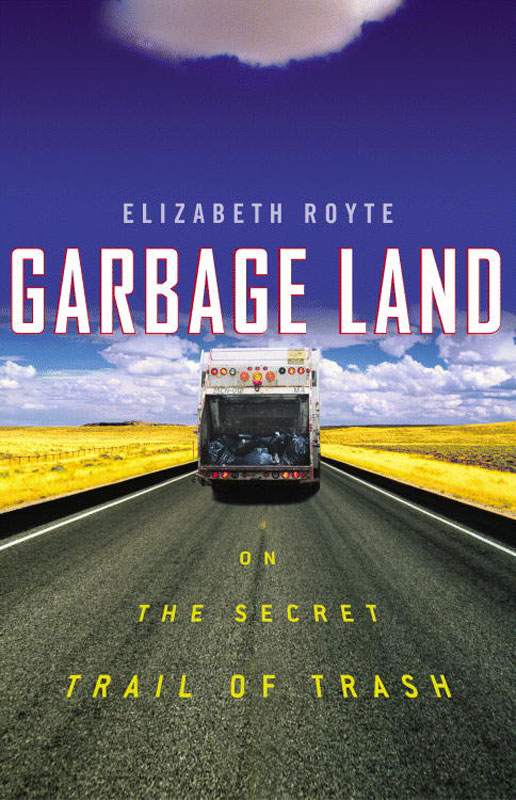Copyright 2005 by Elizabeth Royte
All rights reserved. No part of this book may be reproduced in any form or by any electronic or mechanical means, including information storage and retrieval systems, without permission in writing from the publisher, except by a reviewer who may quote brief passages in a review.
Little, Brown and Company
Hachette Book Group, USA
237 Park Avenue, New York, NY 10017
Visit our Web site at www.hachettebookgroupusa.com
First eBook Edition: July 2005
ISBN: 978-0-316-03073-1
Also by Elizabeth Royte
The Tapirs Morning Bath: Solving the Mysteries of the Tropical Rain Forest
For Peter and Lucy
Quantifying in the Kitchen
O n a sunny spring afternoon long before I ever decided to travel around with my garbage, I slid off the dead end of Second Street, in the Boerum Hill neighborhood of Brooklyn, and down a seven-foot embankment oozing green and brown liquid. I braced my foot on the end of a rotting nineteenth-century beam and prayed that it would hold. It did, and soon I was seated in a slime-encrusted canoe in the Gowanus Canal, my sneakers awash in bilgewater. My life vest and jeans now bore distinctive parallel skid marks. A sportsman in a Gowanus Dredgers cap released the bowline and casually informed me that those row houseshe pointed up Second Streetwere discharging raw sewage into the canal. That would explain the smell, I said.
It was Earth Day 2002, and Id come out not to collect floating garbagethe siren call for two dozen local Sierra Club membersbut to get a little exercise. Id never paddled around the city, and I wanted a new perspective on my neighborhood. I also wanted a backyard view of what the media were touting as up-and-coming real estate. Gowanus, after morphing into the tonier-sounding Boerum Hill in the sixties, was returning as a sales category.
I left the proffered dip net and trash bucket on the embankment and turned the canoe deeper into Brooklyn. It was low tide, and the smell was, even for someone expecting the worst, fairly bada combination of outhouse, mudflat, and mold. The water was a diarrheal brown and topped by a slick of psychedelically swirled oil. I J-stroked past a fuel oil depot, a sewage outfall pipe, and the tin-can-cluttered encampment of a hobo. I glided over submerged shopping carts coated thick with algae and watched as other paddlers plucked spent condomsor Coney Island whitefish, as theyre locally knownfrom the waters surface. It occurred to me, as I turned to work my way out toward Gowanus Bay, that I was paddling through a microcosm of the citys multifarious effluent. In one small, horribly polluted, godforsaken stretch of water drifted household trash, raw sewage, toxic waste, containers that ought to have been recycled, and rapidly putrescing organic debris. With a start, I realized it was all the stuff I got rid of almost daily.
Scanning the canal and its collapsing bulkheads, I wondered if I was complicit in this specific mess. I lived uphill, in Park Slope, and understood that garbage has a tendency to roll down, to settle on the margins. Before this day Id wondered only idly how my detritus disappeared. You cant live in New York or any big city and not be aware that vast tonnages of waste are generated daily. If youre unlucky enough to be around during a garbage strike or an extended snow emergency, those tonnages assume a visceral reality. But most of the time that reality is virtual, because somehow our unwanted stuff keeps disappearing. It moves away from us in piecestruck by truck, barge by bargein a process that is as constant as it is invisible.
Now, as I paddled slowly through the Gowanus feculence, my curiosity grew. I understood that my regular trash went to some kind of landfill, but what about my recyclable tuna fish cans and my plastic shampoo bottles? These containers were tipped into the same truck, but surely the combined waste streams were at some point teased apart. Where, and by whom? And then what? My waste was no longer within my sight or smell, but surely it fell within others. What impact did my rejectamenta have on other living things? Once I started to think about these questions, I couldnt let them go.
I felt drawn to the Gowanus for atavistic reasons (who doesnt like the shore?), but I was also interested in the canal as a backyard conduit and as a junkyard, of sorts. Over the years, the Gowanus had developed a reputation as a dumping ground for the mob; a character in Jonathan Lethems Motherless Brooklyn refers to the canal as the only body of water in the world that is 90 percent guns. Some of New Yorks garbage infrastructure was overt, some was covert, and the Gowanus seemed to fall somewhere in between. The canal was one hundred feet wide and one point eight zigzagging miles long, not counting the three spurs, called basins, that led to the loading docks of warehouses and factories along the avenues. There were enormous gravel barges tied to the canals edge and sunken barges sitting on its bottom. Among the facilities that actually made use of the water were an asphalt plant (which used to incorporate the citys recycled glass into glassphalt); a marine transfer station, where the boroughs residential garbage had, until a year ago, been tipped into barges bound for Staten Islands Fresh Kills landfill; a couple of cement factories; and two fuel oil companies. A guy named Orion lived on a houseboat near Carroll Street, and Lenny the Chicken Man Thomas worked atop the Union Street Bridge, raising the drawbridges when tallish boats requested it and developing recipes for street-cart barbecue when they didnt.
When the Dutch first arrived in Brooklyn, in the early part of the seventeenth century, the Gowanus was a tidal creek that ran through the salt marsh valley between Park Slope, where I lived, and Carroll Gardens. (The word Gowanus comes from the Iroquois chief Gowanes.) Native Americans lived well on fin- and shellfish they collected in the briny waters. The Dutch farmed the local oysters and exported them by the barrelful to Europeoysters as big as dinner plates, Owen Foote, a cofounder of the Gowanus Dredgers Canoe Club, said to me (everyone who talks or writes about New York City oysters uses dinnerware as a measuring stick).
Gradually, dams and landfills altered the salt marshs ecology. In 1849, the New York State Legislature authorized construction of a straightened and walled canal. (Of course, the Gowanus wasnt really a canal, since it didnt connect anything, but creeks didnt qualify for state construction money.) South Brooklyn was rapidly becoming industrialized, and the canal, completed in the late 1860s, was soon lined with stone yards, flour mills, chemical plants, cement works, and factories that turned out paint, ink, and soap. By then, Brooklyn was Americas third-largest city. Barges hauling brownstone and bluestone, lumber and brickthe stuff that built my apartment house and its environs in the 1880sjostled for position in the harbor, waiting to enter the canal.
Almost from the beginning, the Gowanus was a filthy place: with limited tidal exchange to open water, the discharge of raw sewage, combined with unregulated industrial waste, stagnated. Local residents, appalled by the stench, launched a campaign for improvement. In 1911, the city completed construction of the Gowanus Flushing Tunnel, designed to suck 200 million gallons of water a day from the East River, flush it for more than a mile underneath Brooklyn, and then discharge it into the back end of the canal. The neighborhood celebrated the pumps opening on a June afternoon with Miss Gowanus gliding up the canal on a barge, strewing flower petals in her wake. In the years following World War I, the Gowanus moved six million tons of material a year: it was the nations busiest commercial canal.

